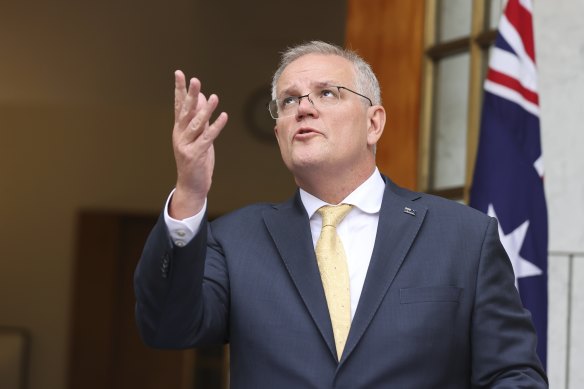By David Crowe
Australians are being told they have received $17 billion in disaster relief over the past three years in a crucial claim from the federal government that has sparked Labor accusations the number has been “fudged” to fight the coming election campaign.
The government has included $13 billion in pandemic measures to the new estimate for its emergency spending while the NSW and Queensland floods heighten a political debate about whether enough is being spent to help disaster victims.

Prime Minister Scott Morrison says relief payments are on the way to flood victims.Credit: Alex Ellinghausen
The spending total also includes $2.8 billion in response to the “black summer” bushfires two years ago and $1.5 billion for previous Queensland floods.
Prime Minister Scott Morrison said about 80,000 claims had already been lodged from people suffering from the floods spreading through parts of Queensland and northern NSW, with 35 local government areas now eligible for the disaster support.
Mr Morrison said $3 million had been paid already through Services Australia with help such as the Disaster Recovery Payment, worth $1,000 for each adult and $400 for each child in a family that qualifies for help.
“The planning is already underway for the recovery and the clean-up operations,” Mr Morrison said.
Emergency Management Minister Bridget McKenzie added more local government areas to the list of regions that could qualify for disaster payments.
“We have made financial help available now because we know the economic impact of disasters like these are felt long after the flood water recedes,” Senator McKenzie said.
“There will be some very tough, days weeks and months ahead for thousands of people in NSW and Queensland and the clean-up and recovery process will take some time.”
The government included the new total for its disaster assistance in press releases this week about the help for flood victims, saying: “since 2019-20 the federal government has provided $17 billion in disaster relief.”
While the government did not specify the pandemic measures included in this total, the National Recovery and Resilience Agency said the pandemic measures were worth $13 billion.
The separate $1.5 billion for the 2019 floods in northern Queensland consisted of $1 billion for the AgRebuild loans for farmers, $232 million for the Queensland government for disaster recovery and $240 million to the Queensland government to pay for grants to primary producers.
The $2.8 billion for the bushfires included $27.1 million to rebuild telecommunications lines and $200 million for native wildlife recovery, but the other funds were not specified in the National Recovery and Resilience Agency’s “impact map” for its funding.
The agency has separately listed $1.8 billion in money already allocated from the National Bushfire Recovery Fund set up two years ago, such as $313 million in local economic recovery programs in Victoria, NSW, Queensland and South Australia.
The Labor spokesman on disaster and emergency management, Queensland senator Murray Watt, said the government was misleading voters by making the pandemic measures part of its claim for disaster spending.
“The Morrison government has failed disaster victims so badly that it needs to pass off COVID support payments as disaster assistance,” he said.
“Scott Morrison and his government should just help disaster victims rather than fudge figures and make announcements they have no intention of delivering.”
Labor has criticised the government for not spending more of the money Mr Morrison set aside in the Emergency Response Fund in late 2019, given the fund is earning more in interest than it is spending on assistance.
The government set up the emergency fund in 2019 using money shifted from the Education Investment Fund, which had been set up by Labor and was meant to fund research. Mr Albanese opposed the shift in funding at the time.
“Why is it that, in order to fund drought relief, you have to take $3.9 billion away from infrastructure funding now in order to give $100 million back in two years’ time, and, in this case, take $4 billion from the Education Investment Fund so that $150 million per year, at a maximum, can be provided to fund recovery measures?” he asked in Parliament in September 2019.
Mr Albanese promised at the time Labor would vote for laws to increase disaster relief – “bang, straight through,” he said – but said this should not come at the cost of education.
The Emergency Response Fund had $4.8 billion in cash and other assets at December 31 after gaining $836 million from earnings, while only having $50 million drawn down to fund commitments.
But the government took more money from the fund in February to pay for new schemes such as the National Flood Mitigation Infrastructure Program and the Coastal and Estuarine Risk Mitigation Program, asking for applications from state and territory governments.
The coastal program is expected to open for applications in March, suggesting the cash may not go to specific projects for several months.
The government estimated it had committed $150 million from the ERF for disaster mitigation.